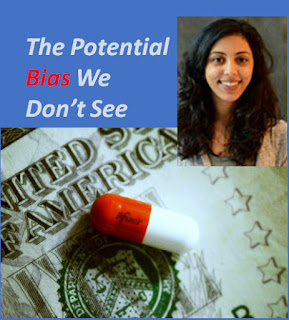The Potential Bias We Don’t See
by Ambica Chopra
MBS 2018, Geisinger Commonwealth School of Medicine
MBS 2018, Geisinger Commonwealth School of Medicine
Mentor: Brian Piper, PhD
A Conflict of Interest (COI) is a clash that happens when personal priorities conflict with professional duties. A COI has existed in many forms, and it may play a role in physician-industry interactions, such as with the pharmaceutical, medical device, or biotechnology industries. For example, a pharmaceutical company could give financial incentives and gifts to health care providers in hopes that they would market that company’s drugs or serve as promotional speakers. This “pharma-provider” interaction has existed for decades and has unknowingly influenced many aspects of healthcare. Research has found that COIs have impacted prescribing practices.
The US government and organizations such as ProPublica have attempted to create greater transparency between doctors and industry by mandating companies to report these financial interactions. The Sunshine Act came into effect in 2007 and required medical industries to report financial relationships with physicians and teaching hospitals, and this financial database became known as Open Payments. Organizations like ProPublica obtain this financial information, and they compiled the finances into a database that was known as Dollars for Docs.
I tested the veracity of Open Payments and Dollars for Doc, and ascertained whether these databases produce equivalent results. I did this by looking at the top fifty causes of death and found an article pertaining to each on Medscape. Medscape was founded in 1995 and contains peer-reviewed, healthcare-related information. Medscape is easily accessible by anyone who creates a free account. Author’s names were recorded on Excel. The names were searched on Dollars for Docs and Open Payments. The years, number of payments, and payment amounts received were recorded and an R2 test was done. The R2 value were close to one (< 0.992) and this proved that both databases produce equivalent results. The only difference was that Open Payments shows entries up to 2015; whereas, Dollars for Docs only reports up to 2014.
I also looked at another data set: the one-hundred most commonly used drugs in the US. I found an article pertaining to each drug. However, there were no authors listed in these articles, so I investigated the financial interests of the Drugs & Diseases Advisory Board who were listed instead. This consisted of eight authors. By using the Dollars for Docs database, I discovered that six of these authors (75.0%) had received financial gains from industries. Analysis of the top 50 causes of death data set using the Dollars for Docs database was then completed. I found that over three-quarters (79.3%) of these authors received financial gains from industries. This research did not examine whether the information presented was impacted in any way. Overall, continued attention should be paid to COI and their potential impact on evidence-based medicine.
A Conflict of Interest (COI) is a clash that happens when personal priorities conflict with professional duties. A COI has existed in many forms, and it may play a role in physician-industry interactions, such as with the pharmaceutical, medical device, or biotechnology industries. For example, a pharmaceutical company could give financial incentives and gifts to health care providers in hopes that they would market that company’s drugs or serve as promotional speakers. This “pharma-provider” interaction has existed for decades and has unknowingly influenced many aspects of healthcare. Research has found that COIs have impacted prescribing practices.
The US government and organizations such as ProPublica have attempted to create greater transparency between doctors and industry by mandating companies to report these financial interactions. The Sunshine Act came into effect in 2007 and required medical industries to report financial relationships with physicians and teaching hospitals, and this financial database became known as Open Payments. Organizations like ProPublica obtain this financial information, and they compiled the finances into a database that was known as Dollars for Docs.
I tested the veracity of Open Payments and Dollars for Doc, and ascertained whether these databases produce equivalent results. I did this by looking at the top fifty causes of death and found an article pertaining to each on Medscape. Medscape was founded in 1995 and contains peer-reviewed, healthcare-related information. Medscape is easily accessible by anyone who creates a free account. Author’s names were recorded on Excel. The names were searched on Dollars for Docs and Open Payments. The years, number of payments, and payment amounts received were recorded and an R2 test was done. The R2 value were close to one (< 0.992) and this proved that both databases produce equivalent results. The only difference was that Open Payments shows entries up to 2015; whereas, Dollars for Docs only reports up to 2014.
I also looked at another data set: the one-hundred most commonly used drugs in the US. I found an article pertaining to each drug. However, there were no authors listed in these articles, so I investigated the financial interests of the Drugs & Diseases Advisory Board who were listed instead. This consisted of eight authors. By using the Dollars for Docs database, I discovered that six of these authors (75.0%) had received financial gains from industries. Analysis of the top 50 causes of death data set using the Dollars for Docs database was then completed. I found that over three-quarters (79.3%) of these authors received financial gains from industries. This research did not examine whether the information presented was impacted in any way. Overall, continued attention should be paid to COI and their potential impact on evidence-based medicine.



Comments
Post a Comment